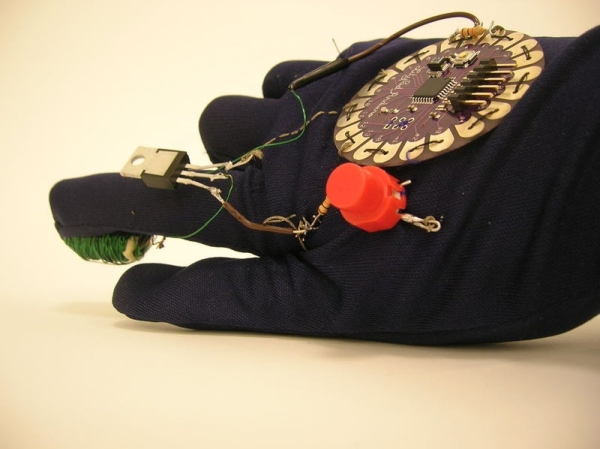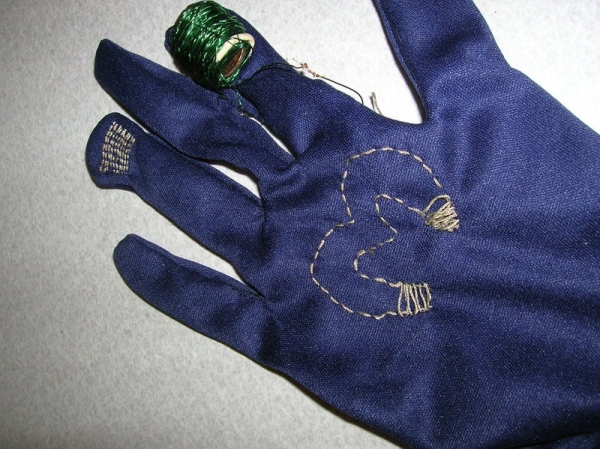For a class assignment, I needed to make something fabric-based which took an Arduino, some programming, and at least two inputs and outputs. After sketching a few different ideas, I hit on this one: an electromagnetic glove for MagnetoGirl. It sprang to life for me, because magnetism is an invisible force which can seem magical. Also, a superhero can be given life, character, and (the best part) a cool costume.

I decided to make an opera glove with some embedded circuitry. The electromagnet is in the index finger of the right hand; the electromagnet (and also the on-Arduino LED for pin13) are on while the red button is held down; there are sensors made of conductive thread on the palm and pad of the ring finger which, when touched together, disable the electromagnet while the button is still held down (but the LED stays on).
MagnetoGirl’s powers are a bit weak right now, though- her glove still has to be plugged in to the laptop for power! Improvements welcome.
Step 1: Materials

Glove:
-fabric
-thread
-needle/sewing machine
-alternately, a pre-made glove, and then you can skip the next step
Circuit:
-Lilypad Arduino & USB cable
-button switch
-soldering iron/solder
-conductive thread & needle
-wire
power transistor
-2 high-resistance resistors (for tie-downs)
-electromagnet
-something conductive
-electromagnet wire
Step 2: Make the Glove

I made my own glove on my sewing machine.
Start with some kind of stretchy, thin fabric. I used dark blue lining that feels like it might be rayon?
Double the fabric over and lay your arm and hand down on it. It should be turned so that the stretch is across your hand- such that the fabric will stretch around your fingers once you sew it. If that didn’t make sense, try this: your fingers won’t get longer while you’re wearing the glove, but they will get fatter when you bend them, so orient the stretch accordingly.
Trace your hand. Don’t do the stupid, lazy thing I did and stick your hand in the sewing machine.
Sew a straight stitch just barely out from the line you traced all the way around your hand and up your arm.
Test the fit- don’t even bother turning it inside out, just stick your hand in it and see how it feels. Good? Good.
Now cut off extra fabric, close but not too close to the seam. If you cut it too big, it won’t fit right. If you cut it too close, you’ll have to mend it.
Turn it inside out and voila! You have made an opera glove.
Step 3: Sew on Conductive Thread Sensors.

(Ignore the electromagnet in first picture)
Conductive thread is thicker than normal thread, which makes it a fine embroidery floss. I cut out a paper template in the shape of MagnetoGirl’s double magnet logo, pinned it to the palm of the glove, and stitched around it. Be careful not to sew the glove together!
The logo is also a sensor, so any extra touches, like the coils on this logo, have to be worked in contiguously.
Once the logo is stitched, turn the glove inside out and continue stitching on the inside of the glove (see second picture). If you just pick up a couple of threads with each stitch, you should be able to sew the conductive thread along so that it’s invisible when the glove is turned right side out again. Stitch it all the way around to the back of the hand so you can bring the thread up through into the Lilypad later.
Do the pad on the ring finger similarly.
Step 4: Sew on Lilypad.

Sew the Lilypad onto the back of the glove (place it while your hand is in the glove). For now, you should probably sew only through pins that you aren’t planning to use, to make it easier to attach the conductive thread later. You can affix it more firmly later.
Before sewing down too much of it, add some conductive thread (see note on next step) to the negative and positive pins and run them through the inside of the glove (separately, of course, and using the invisible-sewing technique from the previous step) all the way over to the other side of the Lilypad. You will need loose ends here as well, to attach to the button.
Leave open pins 5, 8, 10, and 13.
Step 5: Make Electromagnet.

Find a nice, conductive piece of metal. It should be small enough to attach to a fingertip (and allow the finger to bend) but big enough that plenty of wire can be wound around it.
Get a lot of electromagnet wire. You want a length that has at least an ohm of resistance.
Wrap it up! Listen to some Elton John/George Michael while you’re about it.
Hook it up to a power source and make sure you can pick something up with five volts. If you can’t, you can add more coils, get a more conductive core, or find thicker wire.
Read more: Electromagnet Superhero Glove
